Ah, Ireland – the land of lush landscapes, jovial locals, and a rich cultural heritage. But when is the best time to visit Ireland and experience the Emerald Isle in all its glory? We’re here to guide you through the seasons, weather patterns, and unique experiences that await you on your Irish adventure. So, let’s raise a glass to the beauty of Ireland and uncover the ideal time to visit this enchanting island nation!
Key Takeaways
Experience the best of Ireland with unique experiences for each season, from warm summer days to festive winter celebrations.
Enjoy pleasant weather and budget-friendly prices in the shoulder seasons, plus vibrant festivals & events throughout the year.
Embrace Ireland’s temperate climate with 5–6.5 hours of sunshine per day in May/June and its wettest month offering mild temperatures & stunning national parks.
Ireland’s Peak Travel Seasons Explained
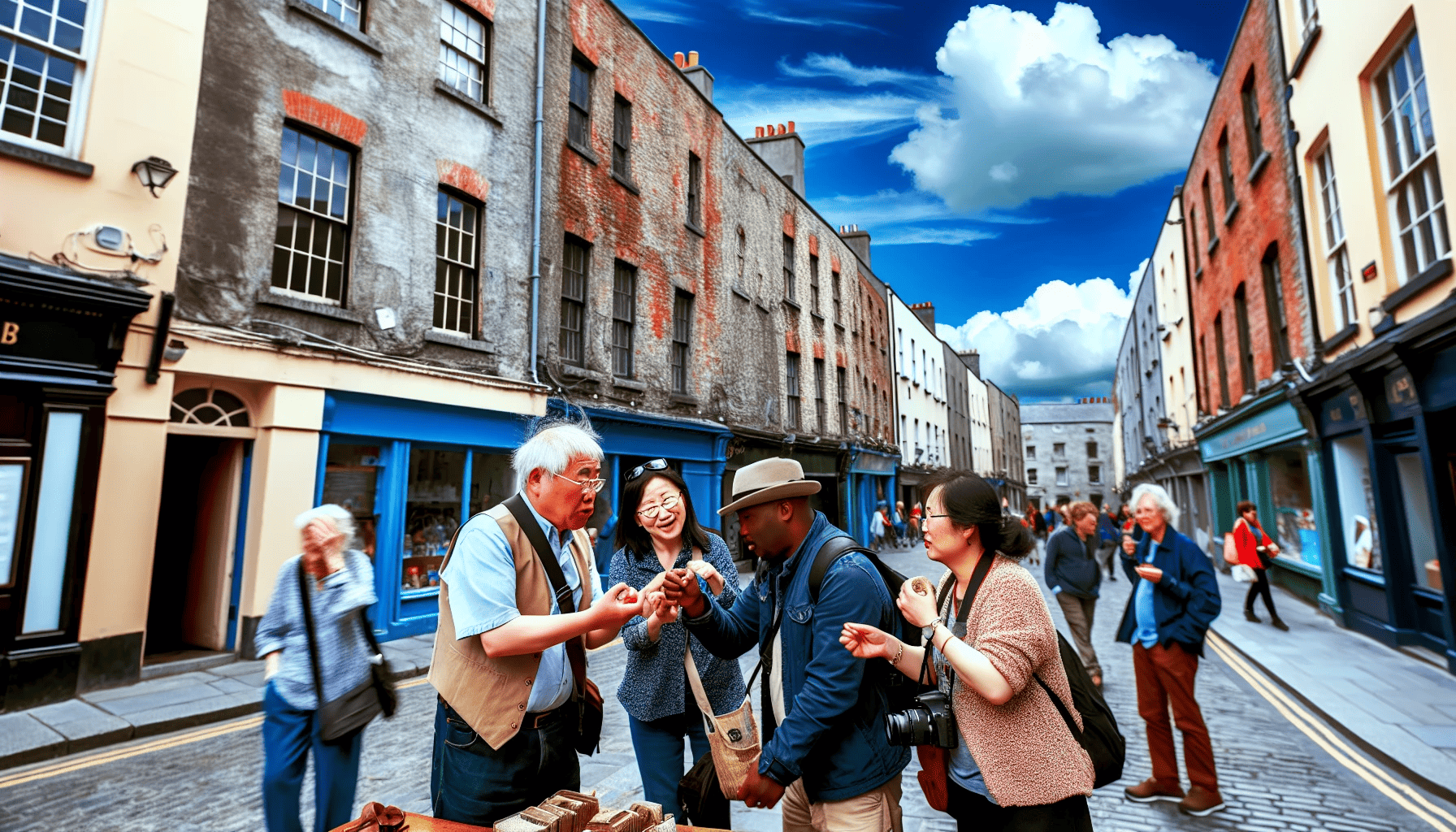
When planning your trip to Ireland, it’s beneficial to grasp the intricacies of each peak travel season. Generally, Ireland’s peak travel seasons can be divided into summer (June-August), shoulder season (April-May and September-October), and winter (November-February). Each season has its own unique charm and advantages, from warm summer days to the festive atmosphere of winter on the west coast.
Summer months are often the most popular time to visit Ireland, with the lure of delightful weather, longer daylight hours, and a bustling atmosphere. Shoulder season offers a balance of mild weather and fewer crowds, making it an appealing option for many travelers. Winter, on the other hand, provides a unique and festive experience with budget-friendly prices and fewer tourists. We will examine the advantages and disadvantages of each season to aid in determining the best time for your Irish adventure.
The Lure of Summer: Pros and Cons
There’s no denying that summer in Ireland is a magical time. With average temperatures ranging between 12°C to 19°C (54°F to 66°F), the warm weather entices visitors to explore the great outdoors and soak up the extended daylight hours. Summer in Ireland offers a wide variety of experiences for every traveler’s taste, including:
Lively outdoor events and festivals
Scenic day trips
Hiking and exploring the beautiful countryside
Relaxing on the stunning beaches
Enjoying water sports such as kayaking and paddleboarding
Visiting historic sites and castles
Sampling delicious local cuisine and drinks
Whether you’re looking for adventure, relaxation, or cultural experiences, summer in Ireland has something for everyone.
However, as with many countries, the summer months are also the peak season, meaning higher prices and larger crowds at popular attractions. To make the most of your summer visit, consider:
Exploring castles and historic sites early or later in the day when there are fewer tourists
Enjoying outdoor activities and nature during the cooler mornings or evenings
Visiting lesser-known or off-the-beaten-path destinations to avoid the crowds
Making reservations in advance for popular restaurants or attractions
Taking advantage of early bird or late-night discounts for certain activities or events
This way, you can still enjoy the best of what summer has to offer without feeling overwhelmed by the hustle and bustle.
The Charm of the Shoulder Season
For those seeking a more tranquil escape, the shoulder season in Ireland may be the perfect choice. Spanning from April to May and September to October, this time provides a balanced experience with pleasant weather and fewer tourists. The shoulder season often sees temperatures ranging from 8°C to 20°C (46°F to 68°F), offering mild conditions ideal for:
exploring the country’s breathtaking landscapes
visiting historic sites and castles
hiking along scenic trails
enjoying outdoor activities such as fishing or golfing
Beyond the agreeable climate, the shoulder season offers decent weather and:
Picturesque landscapes with exquisite lighting, ideal for photography
Occasional storms in October, resulting in dramatic skies and powerful waves crashing onto the rugged coastline, making for captivating images
An idyllic setting for a peaceful Irish getaway
Winter Wanderlust: Ireland’s Off-Peak Appeal
Winter in Ireland, despite its unpredictable weather, holds its own charm and allure. With average temperatures between 4°C and 8°C (39°F-47°F), the season offers a festive atmosphere, budget-friendly prices, and fewer crowds. As you roam the streets adorned with twinkling lights, you’ll find outdoor markets brimming with festive joy and cozy pubs filled with live music and laughter.
Of course, winter also brings its challenges, with shorter daylight hours and some attractions having limited opening hours or being closed altogether. However, don’t let that deter you from experiencing Ireland’s off-peak appeal. The season presents a unique opportunity to explore the country’s cities and villages at a leisurely pace, with the added bonus of lower accommodation prices and smaller crowds at popular sites.
Weather Patterns Across the Emerald Isle
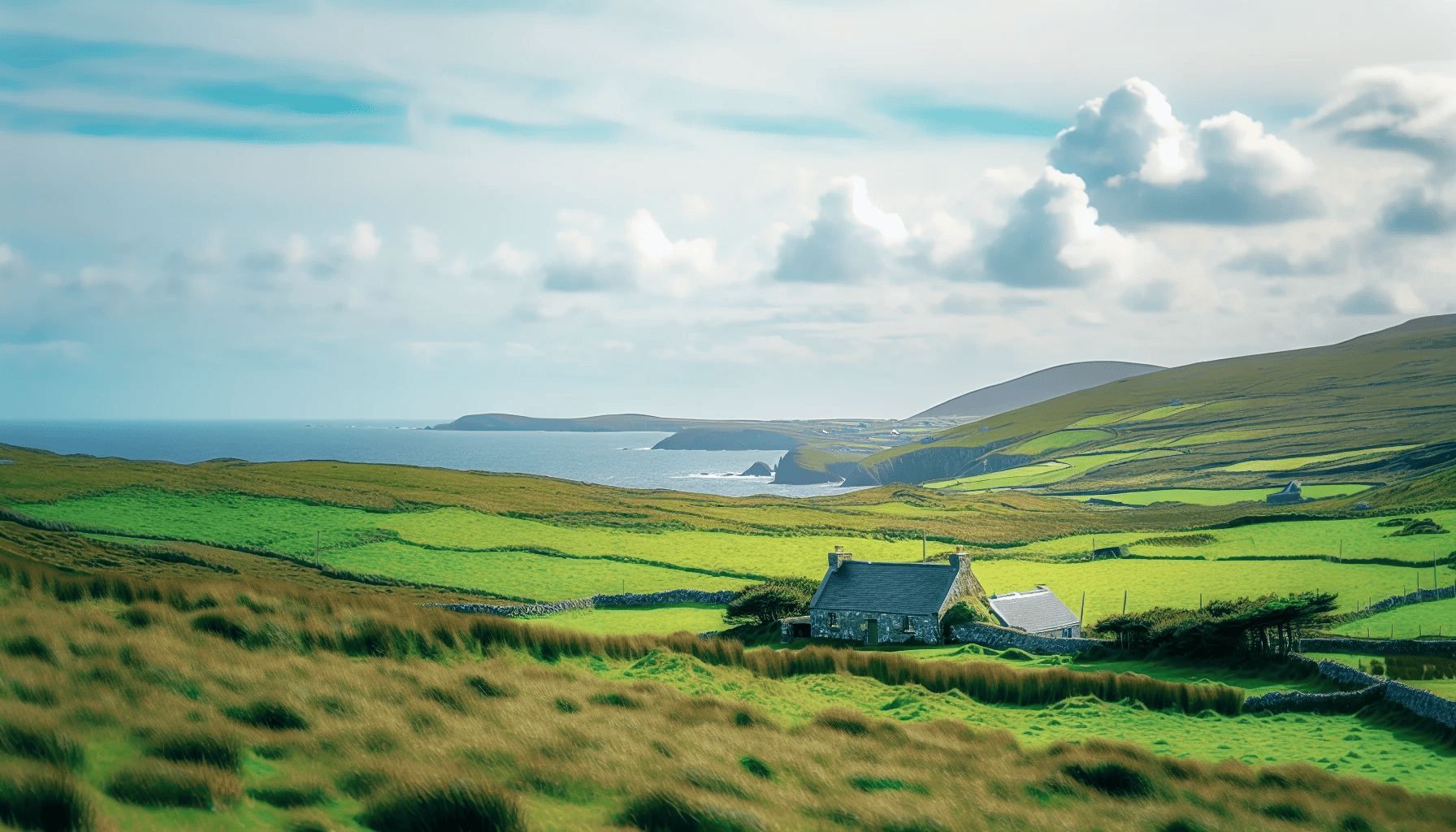
Ireland’s climate is known for being mild and changeable, which adds to the island’s unique charm. Throughout the year, temperatures remain relatively pleasant, making it an ideal destination for travelers from all corners of the globe. The sunniest months are typically May and June, while December often sees the highest rainfall.
So, what can you expect from Ireland’s weather patterns? In general, the Emerald Isle enjoys a temperate climate with mild temperatures year-round. From the crisp freshness of spring to the warm embrace of summer, the vibrant hues of autumn, and the festive spirit of winter, there’s always something to love about Ireland’s ever-changing weather. We will further analyze the optimal times to visit considering both sunshine and rainfall.
Seeking Sun: When Ireland Shines the Brightest
If your heart is set on basking in the Irish sun, then May and June are your best bets. During these months, Ireland enjoys an average of 5 to 6.5 hours of sunshine per day, providing ample opportunities for outdoor activities and sightseeing. The Sunny South-East region, in particular, is known for its delightful weather during this time.
Whether you’re surfing the waves on the west coast, cycling through lush countryside, or hiking the scenic trails of the national parks, the sunniest months in Ireland are sure to leave you with unforgettable memories. Keep in mind that other European destinations might also experience pleasant weather during this period, so planning your trip accordingly is beneficial.
Embracing the Elements: Ireland’s Wettest Month
For those who find a certain charm in the rain, December is often the wettest month in Ireland. With an average of 70mm (3”) of rain over at least 12 days, this refreshing month offers a unique experience for travelers who aren’t afraid to embrace the elements. Despite the rainfall, Ireland’s winter temperatures remain relatively mild, ranging between 5°C and 8°C (41°F and 46°F).
Don’t let the rain dampen your spirits! Winter in Ireland provides an opportunity to explore fascinating museums, like the National Museum of Archaeology in Dublin, or to venture underground in the Marble Arch Caves in Fermanagh. For nature lovers, the stunning Killarney National Park awaits with its ancient oak forests and shimmering lakes. In short, Ireland’s wettest month offers a wealth of experiences for those willing to don their raincoats and embrace the elements.
Optimal Times for Unique Irish Experiences
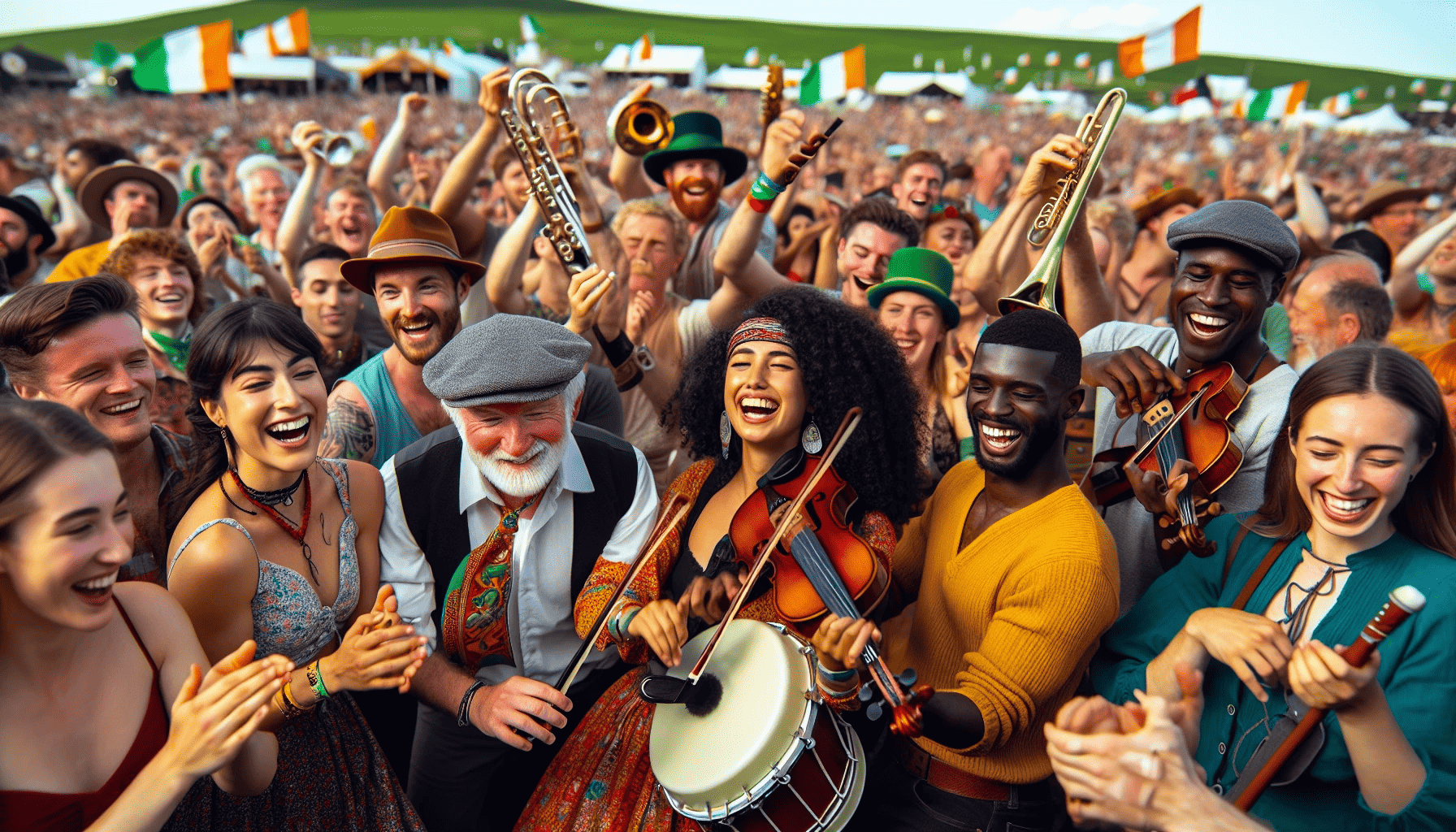
The best time to visit Ireland for unique experiences can vary depending on the activity you’re interested in. Some examples include:
Attending cultural festivals such as the Galway International Arts Festival
Discovering traditional music in cozy pubs
Exploring the breathtaking national parks
Timing your visit to align with these events can make your trip truly unforgettable.
Next, we will discuss the best times to savor Ireland’s distinctive experiences, be it participating in the arts, enjoying traditional music, or appreciating the nation’s natural beauty. Consider these recommendations as you plan your visit to the Emerald Isle.
Cultural Festivities: Galway International Arts Festival and More
Ireland is a country brimming with cultural festivities, and one of the most renowned events is the Galway International Arts Festival. Held annually in July, this vibrant festival showcases an array of artistic performances and exhibitions, drawing visitors from around the world. The 2023 edition of the festival is set to take place from July 17th to July 30th, offering a fantastic opportunity to experience the best of Ireland’s arts scene.
In addition to the Galway International Arts Festival, Ireland hosts a plethora of other exciting events throughout the year. From the lively St. Patrick’s Day celebrations in March to the enchanting Christmas markets in December, there’s always something happening in the world of Irish culture. So, whether you’re a fan of literature, music, theater, or visual arts, Ireland has a festival or event that’s sure to captivate your imagination.
A Melody of Traditions: Discovering Traditional Music
Traditional Irish music is a vibrant and rich tradition that dates back centuries, and there’s no better way to experience it than by visiting the country where it all began. While you can find traditional music sessions year-round in pubs across Ireland, the summer festival season provides an especially lively atmosphere for discovering this unique art form.
Some of the most beloved traditional Irish music festivals include:
The Fleadh
Willy Clancy Summer School
Clifden Traditional Music Festival
TradFest Temple Bar
These events showcase the very best of traditional music, from lively pub sessions to captivating concerts and workshops. So, whether you’re a seasoned trad music fan or new to the genre, Ireland offers a wealth of opportunities to immerse yourself in its melodious heritage.
Natural Splendor: Best Time for National Parks
With its breathtaking landscapes and diverse wildlife, Ireland’s national parks are a must-see for nature lovers. The best time to visit these natural wonders is during the shoulder season, when the weather is mild and the parks are less crowded. From April to May and September to October, you can enjoy serene landscapes adorned with colorful foliage and a peaceful atmosphere.
Some of the best national parks to explore during these months include Killarney National Park, Connemara National Park, and Burren National Park. Each park offers a unique experience, from the ancient oak forests of Killarney to the rugged limestone landscapes of Burren. So, pack your hiking boots and camera, and prepare to be mesmerized by Ireland’s natural splendor.
Planning Your Visit: Practical Tips for Travelers
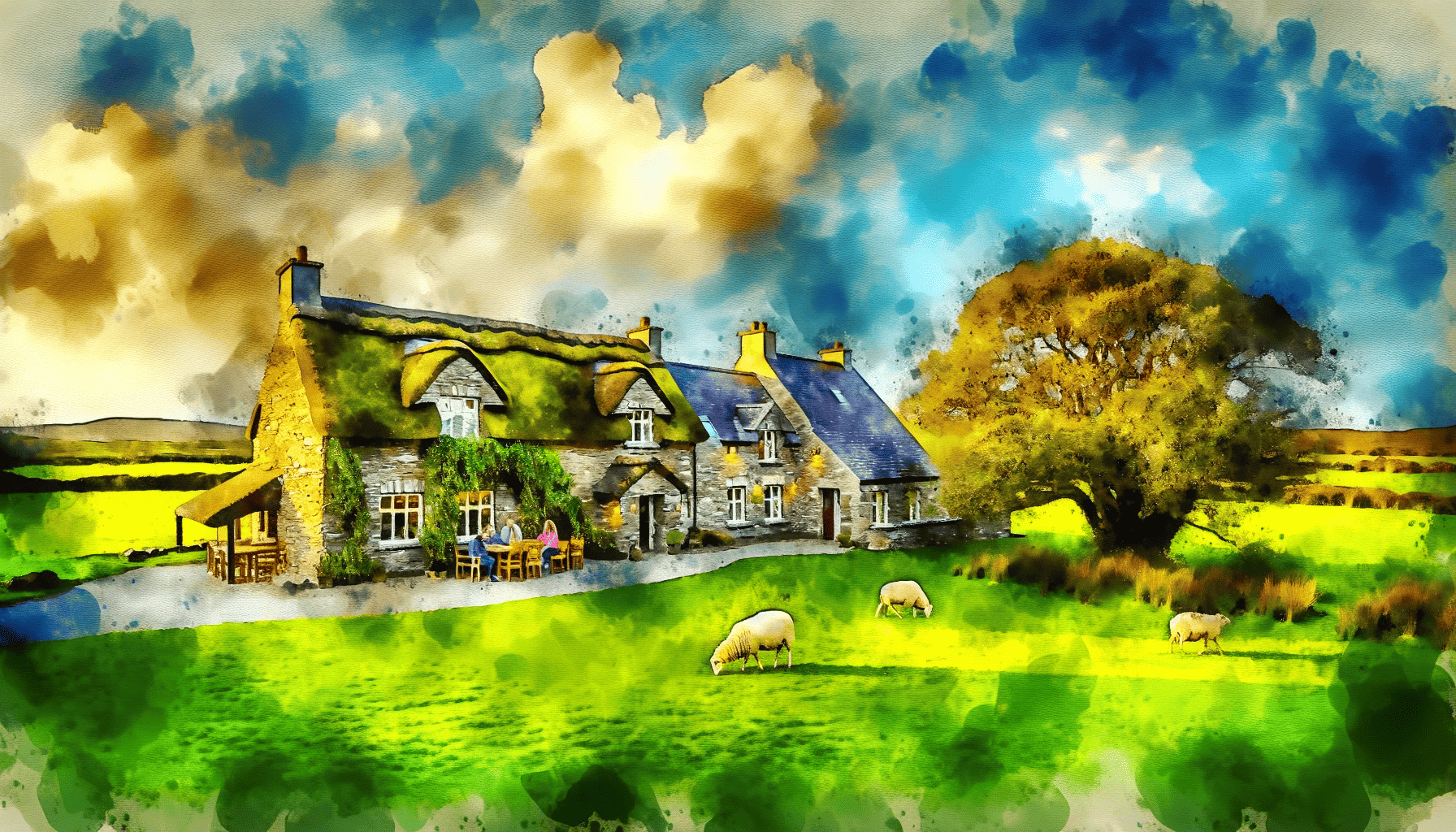
As you plan your visit to Ireland, it’s important to consider not only the best time to go but also practical tips for getting the most out of your trip. From booking accommodations and finding great deals to timing your day trips and city breaks, a little planning goes a long way in ensuring a memorable experience.
Next, we will provide practical advice on securing accommodations, finding excellent deals, and planning your activities for an enjoyable Irish getaway. So, grab a pen and start taking notes – your dream trip to Ireland is closer than you think!
Accommodation Strategy: Booking for the Best Deals
When it comes to booking accommodations in Ireland, timing is everything. To get the best deals, consider booking during the shoulder season or winter months when prices are lower and availability is higher. Websites like Kayak, Booking.com, and Expedia can help you find great value accommodations during these times.
If you’re planning to visit during the summer high season, it’s still possible to find good deals. Be sure to book at least four months in advance and keep an eye out for last-minute offers. No matter when you choose to visit, a little research and planning can go a long way in ensuring a comfortable and budget-friendly stay in Ireland.
Day Trips and City Breaks: Timing Your Adventures
Timing your day trips and city breaks is key to getting the most out of your Irish adventure. The shoulder season and winter months are an ideal time to explore popular tourist destinations, as the weather is milder, and there are fewer crowds. In fact, many attractions may have reduced hours or be closed entirely during these times, so planning your visit accordingly can help you avoid disappointment.
For those looking to experience Ireland’s bustling city life, consider visiting during the summer months when the weather is warm and daylight hours are long. Just be prepared for larger crowds and higher prices during this popular time. Ultimately, the best time for your day trips and city breaks will depend on your personal preferences and the type of experience you’re seeking.
Ireland for All Seasons: Month-by-Month Insights
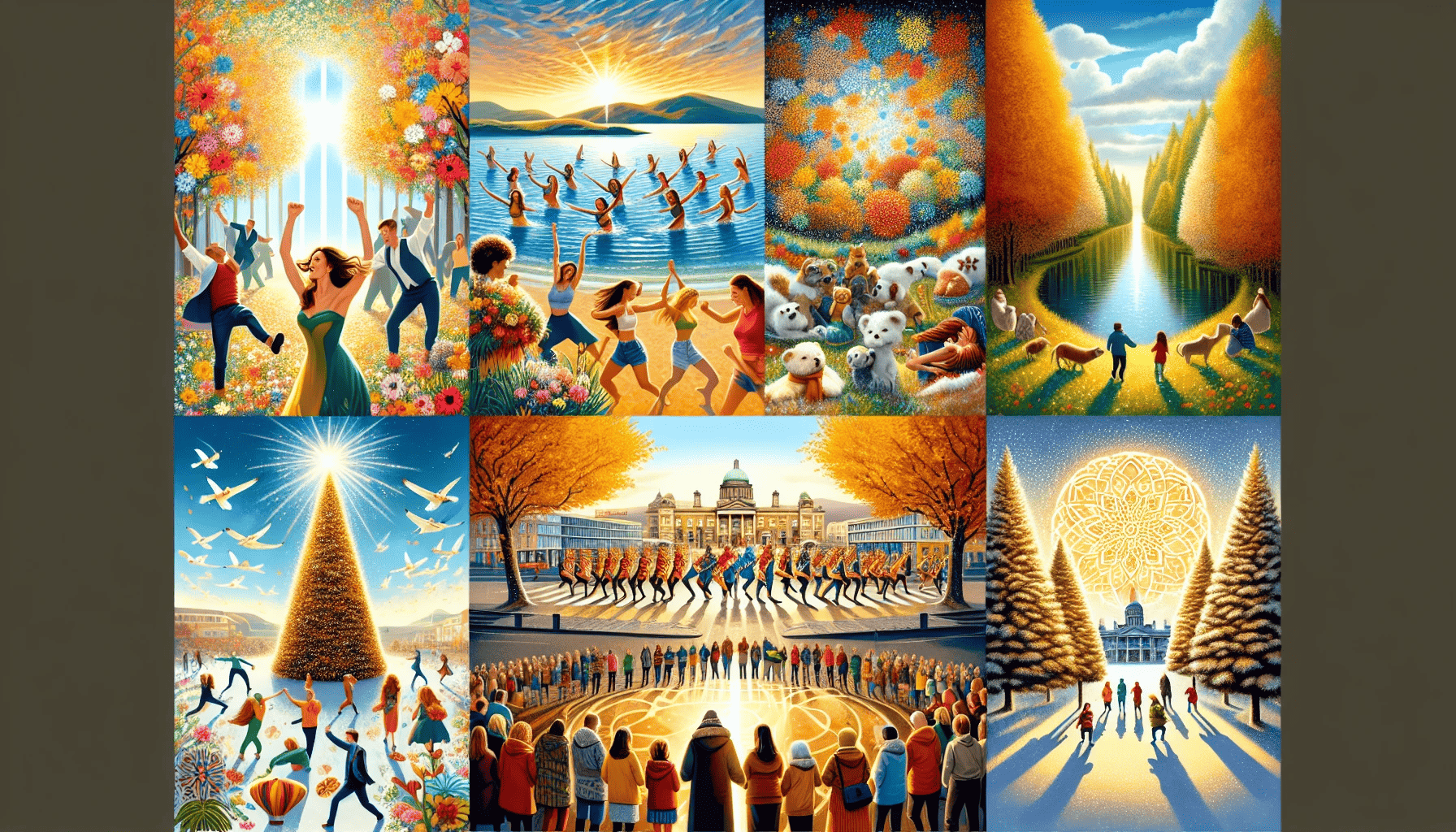
Ireland, including Northern Ireland, offers unique experiences and attractions throughout the year, such as:
Spring festivals
Summer highlights
Autumn serenity
Winter festivities
No matter when you choose to visit, you’re sure to be captivated by the island’s timeless beauty and warm hospitality.
Next, we will provide a detailed breakdown of what each season brings, offering month-by-month insights to assist you in planning your ideal Irish escape. So, whether you’re dreaming of a springtime rebirth, a summer adventure, or a cozy winter retreat, Ireland has something for everyone.
Spring into Ireland: Rebirth and Festivals
Spring in Ireland is a season of rebirth and renewal, with the countryside awash in vibrant colors and a palpable sense of excitement in the air. As the days grow longer and the temperatures rise, the island comes alive with a host of festivals and events, including:
The world-famous St. Patrick’s Day celebrations in March
The Dublin Dance Festival in May
The Galway International Arts Festival in July
The Cork Jazz Festival in October
These events offer a unique opportunity to experience the rich culture and traditions of Ireland during the spring season.
Aside from St. Patrick’s Day, other notable spring festivals include the Dingle International Film Festival and the Dublin Dance Festival. With so many events and activities to choose from, spring offers an exciting and diverse experience for visitors looking to immerse themselves in Ireland’s rich cultural tapestry.
Summer’s Bounty: High Season Highlights
Summer in Ireland is a time of warmth, long daylight hours, and endless opportunities for outdoor exploration. From June to August, the country is abuzz with activity, from lively music festivals and cultural events to scenic hikes and water sports.
Some of the most popular summer festivals in Ireland include the Galway International Arts Festival, Cork Midsummer Festival, and the Fleadh Cheoil na hÉireann (All-Ireland Music Festival). These events showcase the best in Irish music, dance, and culture, attracting visitors from around the globe.
So, if you’re looking to experience the best of Ireland during the summer months, be prepared for an unforgettable adventure!
Autumnal Hues: Late September Serenity
As the summer fades and the days grow shorter, Ireland’s landscape transforms into a kaleidoscope of rich autumnal hues. From late September through October, the country offers a serene and tranquil setting, perfect for those seeking a peaceful getaway.
Autumn is an ideal time to explore Ireland’s national parks, such as Killarney, Connemara, and Burren, where you can marvel at the vibrant foliage and enjoy the crisp, cool air. The season also brings a host of cultural events, including the Dublin Theatre Festival and the Belfast International Arts Festival, providing an enriching experience for art enthusiasts.
Winter Whispers: From Christmas Day Cheer to New Year’s Eve Sparkle
Winter in Ireland offers a unique and magical experience, with festive Christmas markets, cozy pubs, and enchanting New Year’s Eve celebrations. Despite the cooler temperatures and shorter days, there’s a certain charm to be found in the country’s winter atmosphere.
Popular Christmas markets can be found in cities such as Dublin, Cork, and Belfast, providing an excellent opportunity for a city break to shop for unique gifts and sample delicious local treats. As the year comes to a close, the entire country comes alive with New Year’s Eve celebrations, from fireworks displays to lively street parties.
So, if you’re looking for a truly memorable winter escape, Ireland’s festive season is sure to delight and enchant.
Summary
In conclusion, the best time to visit Ireland truly depends on your personal preferences and the experiences you seek. From the warm, bustling summer months to the serene beauty of autumn and the festive charm of winter, Ireland offers a wealth of unique opportunities for travelers throughout the year. So, whether you’re planning a cultural city break, an outdoor adventure, or a peaceful retreat, the Emerald Isle awaits with open arms and a warm Irish welcome.
Frequently Asked Questions
What is the best month to go to Ireland?
The best time to visit Ireland is the summer months (June, July and August) for the good weather and peak tourist season experience.
What month is the rainy season in Ireland?
The rainy season in Ireland typically occurs between October and January, when rainfall averages are the highest, with a total of approximately 130 mm each month.
How many days in Ireland is enough?
Ten days in Ireland is plenty of time to explore the beauty of the island and create a unique and memorable trip. Take your time and visit popular spots like County Wicklow and the Ring of Kerry, or use your extra days to go beyond the classic 7-day itinerary and make your trip truly special.
Where is the best weather in Ireland?
Head to Ireland’s Sunny South-East for the best weather, with an average of five to seven hours of sunshine a day in the summer months. Enjoy the warm and sunny atmosphere!
What is the shoulder season in Ireland?
The shoulder season in Ireland is an ideal time to visit, spanning from April-May and September-October. Enjoy mild temperatures and a variety of activities during this period!

